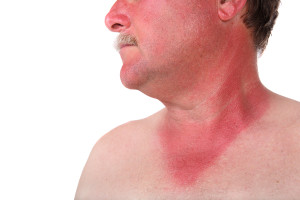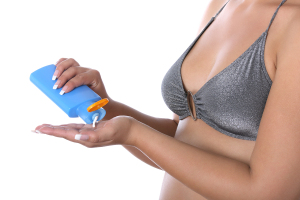Introduction
Sunburns are more common in fair-skinned people. Not every skin is the same. There are 6 skin types that have been defined.
Skin type I always burns, never tans, whereas skin type VI of a black person never burns, always tans. The other skin types are in between. The important distinction between what skin type you are will determine your risk for skin cancer and how much effort you should put in to protect yourself against skin cancer (see link: “Prevention Of Skin Cancer” under “Related Topics” below).
After prolonged sun exposure there will be a point reached where a sunburn occurs in everybody. However, this burning point is reached much earlier for a person with skin type I or II compared to a person with skin type IV or V.
This comes from absorption of the UV rays, of which there are two important components, the less potent UVB rays, which are blocked by PABA type sunscreen lotions, and the more potent UVA rays.
As only UVB rays are the ones we can feel as a burn, we tend to protect ourselves against those. However, on the longterm it is the amount of UVA light that is responsible for premature aging of the skin, for suppression of the immune system and for ultimately causing melanomas (look for “Melanoma” under “Related Topics” below) and non pigmented skin cancers (look for “Skin Cancer” under “Related Topics” below).
Signs and Symptoms
There are mild and moderate sunburns that can be caused by sun exposure. With a mild sunburn there is reddening and pain in the area of sun exposure. The burn is only on he surface and it is the equivalent of a first degree burn that would occur by scalding the skin with hot water. With extreme sun exposure blisters are forming and the patient develops a second degree burn, which affects the deeper layers of the skin.
Treatment
Treatment of sunburns is symptomatic. There is no known treatment modality that would speed up the healing. A minor sunburn (first degree) will usually heal in 1 to 3 days. A blistering sunburn (second degree) will take several days and up to 1 or 2 weeks to heal. Cold compresses applied and exchanged for new ones frequently is the most soothing treatment. Although topical corticosteroid creams will help perhaps on the short-term for the burning, the inflammation and the swelling, it does not objectively help for the damage of the skin surface. Time will heal the skin, but when frequent sunburns are occurring in the same area, there will be sun damaged cells that accumulate, out of which actinic keratoses (look for “Premalignant Skin Cancer” under “Related Topic” below) and skin cancer will eventually develop. The key is prevention of frequent sunburns by application of sunscreen lotions.
In the case of extensive second degree sunburns the patient may have to be admitted to hospital for a few days for pain control, topical treatment with silver sulfadiazine (brandname: Flamazine),telfa pads and gauze dressings as well as possibly systemic antibiotics and/or corticosteroids to mitigate the inflammation and prevent bacterial superinfection of open blisters.
Sunscreen facts
______________________________________________
Two myths have to be mentioned (see Ref. 5, p. 890) in order to be demystified:
Myth # 1:”Self-tanning in a tanning salons provides protection against skin cancer”.
Answer: The truth is that those who go to tanning parlors have skin type III and IV and by definition do not tan easily. They can at the most tan to a sun protection factor equivalent of 6 to 8. Those with skin type I and II should not go to tanning salons, because they would be exposing themselves to a higher risk of skin cancer as they cannot tan.
Myth # 2: “Oral tanning is safe and protects against skin cancer”.
Answer: The truth is that oral tanning is safe (from a chemical point of view), but completely ineffective in terms of preventing skin cancer.
______________________________________________
Remember that one ounce of prevention is worth a pound of cure!
Prevention
The PABA type sunscreen lotions (oxybenzones, cinnamates, salicylates, and anthranilates) will only block UVB rays. The UVA rays of the UV light still can penetrate the skin and cause skin cancer down the road.
Unfortunately we feel only the burn from the UVB light and with the help of PABA type sun blockers are pushing to expose ourselves longer to sun light.
This approach will only promote further skin damage to the deeper parts of the skin (from UVA rays).
This causes skin cancer, perhaps at a slightly lower rate because we removed the repeat sunburns from UVB rays from the overall skin cancer risk setting (Ref. 5, p. 890). Those who “must” be out in the sun can buy the best sun block that will protect against UVA rays as well.
They contain benzophenones, mexoryl or dibenzoylmethane. To block sun rays completely on the nose or the lips, zinc oxide or titanium dioxide are useful agents. It is advisable to avoid he “high-noon sun” between 11:00AM and 2:00 PM to escape the most concentrated UVB and UVA rays of the sun.
There is one additional factor you may want to consider during the summer season: taking a supplement derived from a tropical fern that has proven sun screen effects protecting the deeper skin layers from UVA rays. See this blog for more information.
References:
1. Habif: Clinical Dermatology, 3rd ed.,1996, Mosby-Year Book, Inc.
2. The Merck Manual, 7th edition, by M. H. Beers et al., Whitehouse Station, N.J., 1999. Chapter 117.
3. Cotran: Robbins Pathologic Basis of Disease, 6th ed.,1999, W. B. Saunders Company
4. Noble: Textbook of Primary Care Medicine, 3rd ed., 2001, Mosby, Inc.
5. Rakel: Conn’s Current Therapy 2001, 53rd ed., 2001, W. B. Saunders Company
6. Goroll: Primary Care Medicine, 4th ed., 2000, Lippincott Williams & Wilkins
7. Richard J. Lewis, M.D. at the 42nd Annual St. Paul’s Hosp. CME Conf., Nov.1996, Vancouver/BC
8. Jerry Shapiro, Prof. Dermatol., UBC, at 45th Annual St. Paul’s Hosp. CME Conf., Nov.1999, Vancouver/BC
9. D Seager Int J Cosmet Surg Vol 6, No. 1, 1998: 27-31.
10. Townsend: Sabiston Textbook of Surgery, 16th ed.,2000, W. B. Saunders Company
11. Ferri: Ferri’s Clinical Advisor: Instant Diagnosis and Treatment, 2004 ed., Copyright © 2004 Mosby, Inc.
12. Rakel: Conn’s Current Therapy 2004, 56th ed., Copyright © 2004 Elsevier








